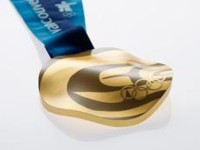Recycled Metals Become Olympic Gold
 Vancouver, BC - As unique as the world’s top athletes and their awe-inspiring performances, every medal won at the Vancouver 2010 Olympic and Paralympic Winter Games will be a one-of-a-kind work of art.
Vancouver, BC - As unique as the world’s top athletes and their awe-inspiring performances, every medal won at the Vancouver 2010 Olympic and Paralympic Winter Games will be a one-of-a-kind work of art. Teck Resources, a Vancouver-based diversified metals company, is supplying the metals used in the production of the Olympic and Paralympic medals.
“Our employees worldwide are honoured to supply the metals for the medals that will be cherished by the world’s best winter athletes in 2010,” said Teck’s president and CEO, Don Lindsay.
“We’re also excited that these medals will contain recycled metal recovered from end-of-life electronics, consistent with the sustainability philosophy of the Olympic and Paralympic Games.”
The medals, revealed last week, each feature a different crop of larger contemporary Aboriginal artworks and are undulating rather than flat - both firsts in Games history.
The dramatic form of the Vancouver 2010 medals is inspired by the ocean waves, drifting snow and mountainous landscape found in the Games region and throughout Canada. The Olympic medals are circular in shape, while the Paralympic medals are a superellipse, or squared circle.
Both are equal in size. Their significant weight - between 500 grams to 576 g depending on the medal - represents the magnitude of the athlete’s accomplishment. The Olympic medals are 100 millimetres in diameter and about six mm thick, while the Paralympic medals are 95 mm wide and about six mm thick. They are among the heaviest medals in Olympic and Paralympic history.
The gold, silver and bronze medals were designed with direct input from Olympic and Paralympic athletes who shared their experiences about medals they won at past Games and what they would like to see in future medals.
Their stories and dreams helped shape the medals, which are being produced and supplied by Vancouver 2010 Official Supporters the Royal Canadian Mint and Canadian mining and metals giant Teck Resources Limited, in collaboration with the Vancouver Organizing Committee for the 2010 Olympic and Paralympic Winter Games (VANOC).
“An Olympic or Paralympic medal is a cherished possession for every athlete - it’s what we all strive for when we train and compete,” said Jill Bakken, an Olympic gold medallist for the United States in bobsleigh at the Salt Lake 2002 Olympic Winter Games. “To feel it being placed around your neck on the podium or seeing children’s eyes light up when you show it to them are experiences that defy words. Seeing these beautiful medals today makes me wish I was competing again in 2010.”
Daniel Wesley, a five-time Paralympian and 12-time medallist for Canada in alpine skiing and wheelchair racing at the Summer and Winter Games, agreed. “Every one of my medals has meaning and motivation because of the memories attached to them and the people I’ve been able to share them with, from family and friends to the crowds in the stadiums on those days.
The 2010 Paralympic medals - and the care taken by the design team to ensure they’re equal in size to the Olympic medals yet still unique in their artwork and shape - demonstrates to me, the public and other Paralympians how greatly our accomplishments and stories are valued.”
The medals are based on two large master artworks of an orca whale (Olympic) and raven (Paralympic) by Corrine Hunt, a Canadian designer/artist of Komoyue and Tlingit heritage based in Vancouver, BC. Each of the medals has a unique hand-cropped section of the abstract art, making every medal one-of-a-kind.
For example, each medal will include its own signature elements of the orca and raven artwork, such as the suggestion of the orca’s eye, the curve of its dorsal fin, or perhaps the contours of the raven’s wing. A silk scarf printed with the master artwork will be presented to each Olympian or Paralympian with their medal enabling them to see how their medal connects with those awarded to other athletes at the Games to make the whole design.
“The ultimate symbol of a dream come true for an athlete is an Olympic or Paralympic medal,” explained VANOC’s Chief Executive Officer John Furlong. “They are the reward for years of effort and sacrifice on the part of the athlete and have the power to inspire children and lift the spirits of an entire country.
“This two-year project has been a truly collaborative effort between inspired designers, artists and craftsmen who dedicated themselves to the challenge of finding beautiful, uniquely Canadian designs to honour the medallists and tell the stories of the Vancouver 2010 Winter Games,” he added.
For more information on the medals for the Vancouver 2010 Olympic and Paralympic Winter Games, visit www.vancouver2010.com.
For More Information: Teck ComincoYou can return to the main Market News page, or press the Back button on your browser.

